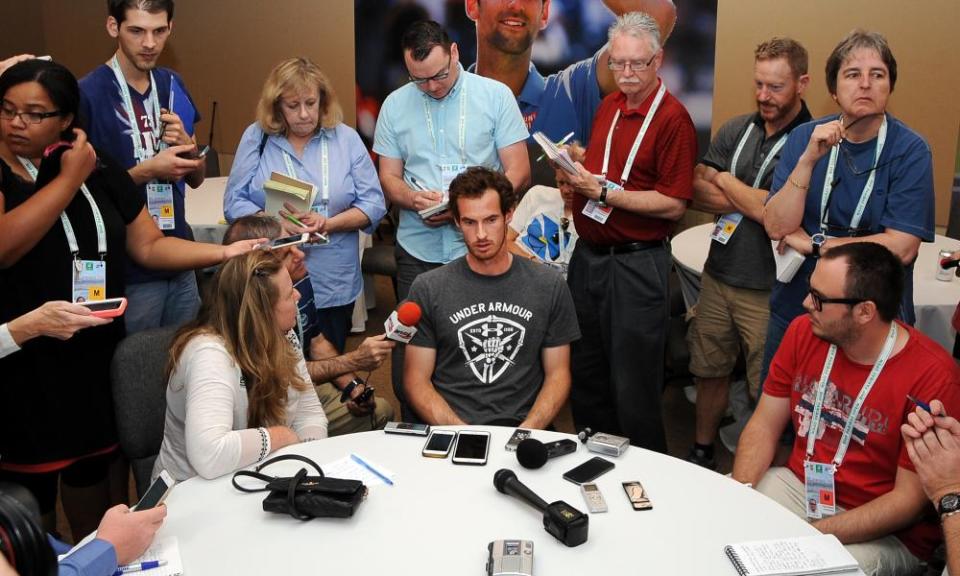Why women's golf could desperately use an Andy Murray

Last week Andy Murray wrote an op-ed for the BBC highlighting the reasons why he’s so outspoken on behalf of women’s tennis. My heart, along with other women in sports, swooned over this, and in particular, my heart skipped a beat when he wrote, “Anyone who has spent any time with any of the top women will know that they make those same sacrifices and are as determined and committed to winning as any of the top men on the tour.”
Murray embodies what a male advocate for women’s sports should be. Recently he shot down a reporter when he incorrectly stated that Sam Querrey was the first US player to reach the semi-finals of Wimbledon since 2009, to which Murray replied, “Male player.”
The confused reporter said, “I beg your pardon?”
Murray replied again, “Male player.”
When he won gold for the second time in Rio last year, he corrected BBC commentator John Inverdale when he congratulated Murray on being the first to win two gold medals in tennis.
“I think Venus and Serena have won about four each,” he replied.
Did I mention that I love this man?
As someone who played a short while on the LPGA circuit and developmental tours, I can speak to the sacrifices and hard work that my colleagues made in order to compete. I can also speak to the casual sexism we often faced, be it from spectators or when we played with sponsors of the tournaments before competition began.
Common questions asked:
“Do you hit with ladies’ shafts?” The answer is no, and I hit it further than you.
“Do you hit from the ladies’ tees?” The answer is also no.
“Would you sleep with someone so they’d sponsor you?” This is how desperate some of the men thought we were.
“Do women hook up with each other on tour?” Can you imagine this same question being asked to PGA Tour players?
The last question, in particular, always rubbed me the wrong way because it infuriated me to think about all the women I played on tour with and how our hard work was being reduced to being asked questions about who we sleep with.
Now, in my next career as a sports journalist, I write and think about women’s golf a lot. But the biggest question I find myself trying to answer is how to get people to take us more seriously.
While better and more equal media coverage is an essential part to providing more legitimacy to women’s golf – I’m looking at you Golf Magazine and Golf Digest – I’m beginning to believe that women’s golf needs its own version of an Andy Murray.
Yes, the LPGA needs a crusader, preferably a big name like Rory McIlroy or Jordan Spieth, to stand up and say, “Y’all should be paying attention to women’s golf because they are amazingly talented athletes.”
The question remains, how would they advocate?
Well, first, they could talk about how women golfers don’t receive enough credit. For instance, they could bring up the fact that Lydia Ko, who was the world No1 at 17 years-old, has 19 professional wins, won silver at the Rio Olympics and has never been on the cover of any major golf publication.
PGA Tour players could attend women’s golf tournaments and show support from the sidelines, the same support the women give when they attend PGA Tour events.
The men could also advocate for equal pay in the US Open, a topic I wrote on, and something Murray has advocated for in tennis: “I think there should be equal pay, 100%, at all combined events. Crowds are coming to watch the women, as well. The thing doesn’t stack up. It changes depending on the matches. Men’s tennis has been lucky over the last nine or 10 years with the players they’ve had. That’s great, but the whole of tennis should capitalize on it, not just the men’s game.”
Now, before some of you trample all over me, I understand the nuances between tennis and golf. Yes, the LPGA and PGA aren’t ran by the same organization. Yes, men and women in golf don’t play the same venues. I. Get. It.
However, these nuances should not preclude male players from showing support and helping elevate women’s golf to receive more support. It should not keep them from talking about how male only golf clubs still exist, or that even the top players on the LPGA still don’t have sponsors or get paid by equipment companies.
The strongest response I’ve heard in favor of women’s golf is when McIlroy spoke out against Muirfield Golf Club’s men’s-only membership policy after they changed the policy. Even then, his response did not directly speak on behalf of professional women’s golf.
Truth is, I don’t even know if many of the PGA Tour players know who LPGA golfers are, or if they watch women’s golf. While there are players on the PGA Tour who I know are friends with LPGA players, I fail to see the men truly use their platforms to lift up the women golfers they are close to.
Women’s golf has grown immensely over the last seven years under the leadership of LPGA commissioner Mike Whan, and this year, the Solheim Cup had the largest TV viewership in women’s golf history. And they’ve accomplished this without male golfers showing any outward love and support.
Now imagine how women’s golf could grow if PGA players stepped up offered their voice to calling out sexism in golf media or called out to sponsors to support women’s golf? Would it change much? Who knows. But it would be fun to find out.

 Yahoo Sport
Yahoo Sport 





































